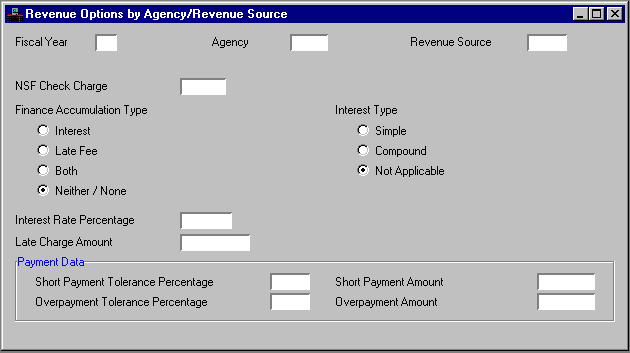|
|
|
|
Fiscal Year
|
Required. Enter the fiscal year for which the revenue options are valid.
|
|
Agency
|
Required. Enter the agency for which the revenue options apply. See Agency Index (AGCY) for valid values.
|
|
Revenue Source
|
Required. Enter the revenue source for which the revenue options apply. See Revenue Source Index (RSRC) for valid values.
|
|
NSF Check Charge
|
Required. Enter the standard charge applied against a customer's account for non-sufficient funds (NSF) checks.
|
|
Finance Accum Type
|
Default is inferred from Revenue Options (ROPT). Defines the type of finance charge which is applied against delinquent receivable lines. Valid values are
I
(interest),
L
(late fee),
B
(both), or
N
(neither).
|
|
Interest Type
|
If
Finance Accumulation Type
is
I
(interest), this specifies whether
S
(simple) or
C
(compound) interest is accrued.
|
|
Interest Rate Percentage
|
Specify the annual percentage interest rate applied against delinquent receivables.
|
|
Late Charge Amount
|
Specify the amount of a one-time late charge applied against delinquent receivables.
|
Payment Data
|
|
Short Payment Tolerance Percentage
|
Required. Enter the maximum percentage of payment under the billed amount that you can enter and still have the system accept it as a full payment.
|
|
Short Payment Amount
|
Required. Enter the maximum dollar amount of payment under the billed amount that you can enter and still have the system accept it as a full payment.
|
|
Overpayment Tolerance Percentage
|
Required. Enter the maximum percentage of payment over the billed amount that you can enter and not create a credit balance on the receivable for the overpayment.
|
|
Overpayment Amount
|
Required. Enter the maximum dollar amount of payment over the billed amount you can enter and not create a credit balance on the receivable for the overpayment.
|




